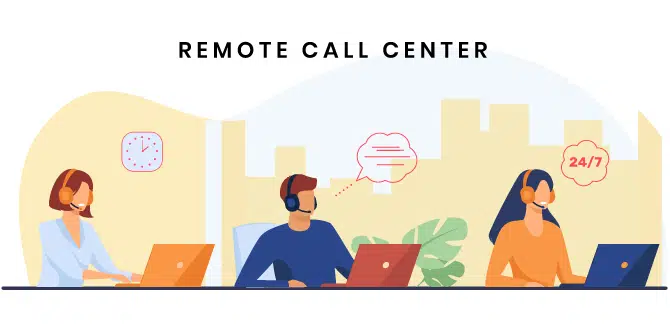Are you looking to start a call center business? Customer support is now different. Service providers like call centers are expected to keep up with the rising standards set by technologies and other conveniences for both customers and employees.
Furthermore, it is not surprising that today’s consumers have larger expectations than in the past. Customers today have a wide range of options to choose from when looking for reviews, comparing items, and getting in touch with customer service departments. However, you can don’t establish your business overnight. Make strategies, hire the right people, and implement advanced tools and technologies to run your business effectively.
What is a call center?
A workplace specifically designed to receive and handle a high volume of phone calls from clients and potential consumers is known as a call center. Call centers for customer care offer guidance and assistance with a company’s goods and services. Call centers can be set up to handle inbound and outbound calls for sales and marketing, lead generation, customer service, IT support, and other company needs.
Difference between a call center and a contact center
| Differentiate points | Contact Center | Call Center |
|---|---|---|
| Communication Channel | Phone, live Chat, Email, social media, and more | Phone |
| Workforce Management | Reduce dependence on agents. | Requires high dependence on agents. |
| Queue Management | Omnichannel queue management across channels. | Call Distribution |
| Self-service Management | Support chatbot, a self-service portal, and community forums. | IVR system |
| Workflow Automation | Create tickets, updates, and time-based triggers. | Voice mails, outbound dialing, and call routing. |
| Unified customer view | 360-degree view of customers with integration. | Not applicable. |
| Usage | Customer service and customer relationship management. | Telemarketing, Technical support, and sales. |
What are the types of call center
Before initiating to start a call center business, you must understand the types of call centers depending upon the services you will provide. Let’s get started:
1. Inbound call center
Interact with a firm, making the agent and their workplace a top priority for any company. Good hiring practices and extensive training are insufficient. Additionally, inbound call centers need to make sure that agents are competently managed, surrounded by high-performing coworkers, employed in a clean, well-maintained space, given a flexible schedule, and given the resources necessary to engage, motivate, and deliver the level of customer service that is expected.
In the inbound call center agents handle the customer calls that’s why it’s important to hire energetic agents to deliver high-quality customer experience.
2. Outbound call center
In an outbound call center, calls are made to the customers to sell your product or services. There are several reasons that companies choose outbound dealings such as collections, surveys, sales, fundraising, and proactive customer notifications. Besides all these reasons, outbound call centers focus on improving conversion rates and higher ROI.
Outbound call centers frequently utilize software tools called dialers that enable keeping their compliance with the above-mentioned requirements while also increasing efficiency and effectiveness.
For example, predictive dialers use advanced algorithms to forecast agent availability in addition to automating phone number dialing. This maximizes agent utilization by ensuring that they are kept active and not idle. Additionally, Predictive dialers are considerably more effective when they are integrated with CRM software because this enables agents to view customer information, resulting in a more pertinent, customized call.
3. Blended call center
A type of call center where agents handle both inbound and outbound calls. There are benefits of a blended call center, many of which might raise client satisfaction. A blended contact center can schedule outbound calls to check in with customers while incoming contact centers wait for the consumer to need service.
It seems difficult, but creating a blended call center is often the best option for you. By having this call center, you can get higher customer retention which improves your business profitability.
Remote vs in-house call center
In-house call center
A company’s own call center is referred to as an in-house call center. Every member of the team is employed by the business, which also maintains all of the tools. A dedicated staff must be hired to manage, operate, and perform all activities for an in-house call center.
Remote call center
A remote call center uses a staff of representatives who work from homes rather than an office environment to perform the same customer care tasks. A remote team collaborates online by using cloud-based call center solutions to communicate with clients and team members rather than in-person.
How to plan your call center
Before starting your call center business, design a strategy to set all resources and maintain your business flow.
1. Set your goal
Before diving into hiring, start by asking yourself why you start this business. After defining your goals clearly, decide how you run your call center successfully. Additionally, decide your goals according to your business demands that save your cost and generate more revenue. The main goals for an effective call center are:
- If you want to run a small call center, your main goal is to generate more leads to streamlining your business operations.
- If you are running a large business, your main goal is to deliver excellent customers to increase customer retention and better business reliability.
- Set your mission and how it aligns with your team and business.
Here are some essential call center Metrics
When you clear your main goals, it’s time to use call center KPIs to track your call center service’s success.
Call center KPIs
Elaborate some important call center metrics that are necessary to measure business performance.
First Response Time
Reduce customer wait time and resolve their issue as soon as possible.
Average handle Time
This metric defines how much time to take talk with the customer.
Average Talk Time
The communication time between an agent and a customer includes hanging time.
Transfer Rate
The percentage of incoming calls that agents transfer to other teams or departments.
Unanswered Calls
The number of calls that agents don’t receive.
Measure above all factors to improve your call center productivity and run your business successfully.
2. Determine budget
If you’re thinking about starting a call center business, one of the most important things to keep in mind is the financial side of things. Before you get started, you need to make sure that you have a good handle on your finances and that you’re prepared to invest the time and money necessary to get your business off the ground.
Make sure to include all of the start-up costs associated with launching your business, such as office space, equipment, and employee salaries.
Once you have a clear understanding of your financial situation, you can start looking for funding sources to help get your business up and running.
3. Define your business type
Examine the main goals and decide which type of call center business is best for you. Each type of call center has different benefits and helps to accomplish your goals. So, first, align your business needs then decide a call center type.
Once your call center business is up and running, it’s important to keep an eye on your finances and make sure that you’re staying within your budget. Keep track of your income and expenses so that you can identify any areas where you may be overspending. If you find that you’re consistently spending more than you’re bringing in, take steps to cut costs or increase revenue to get back on track.
4. Build and train your team
A call center business is only as good as its staff. That’s why it’s important to take the time to find the right people for the job.
Here are a few things to keep in mind when hiring your staff:
- Find people with good customer service skills. This is the most important quality you can look for in a call center employee.
- Look for detail-oriented people. Call center employees need to be able to pay attention to detail to accurately handle customer inquiries.
- Find adaptable people.
- Make sure your employees have a positive attitude. A positive attitude is essential for dealing with customers on the phone.
Schedule training and train your staff with new technologies to streamline business operations.
5. Utilize modern tools and technologies
Call centers cannot operate effectively without modern tools and technology because advanced tools bring more accuracy and streamline business operations. Today’s most successful call centers utilize the advanced technology to deliver exceptional customer service. Train your team and make them comfortable with technology like:
ACD (Automatic Call Distribution):
Route customers call to the best-suited agent or department and handle large volume of calls effectively. Furthermore, meet your customer needs in an efficient way.
IVR (Interactive Voice Response):
An automated system that enables incoming callers to get the information they require without speaking to a live person. Callers can assist themselves by speaking into the phone or entering information using a keypad.
Call Recording system:
Capture customer interactions and helpful for measuring the performance. Call recording and analytics reporting work together to provide the real-time information that contact center managers need.
VoIP:
Over the past few years, VoIP has mostly replaced traditional phone services in businesses. Most organizations choose VoIP over conventional phone lines. Employees can utilize desk phones or download an app for flexibility.
Predictive dialer:
Dial multiple numbers automatically and save agent time as well as detect busy signal, unanswered, and unproductive numbers.
CRM (Customer Relationship Management):
CRM software provides agents with 360° customer information. Agents may be more effective at handling client complaints if they have a record.
PBX (Private Branch Exchange):
A PBX is a network-shared internal company phone system that has various phones. These may still be used by legacy contact center systems. However, they are frequently updated to a virtual or hosted PBX instead of on-premises options.
Conversational AI:
Voice bots are AI-driven, round-the-clock virtual agents who can give users basic information whenever they need it and direct them to the most qualified agent when necessary.
6. Organize call center processes
You’ve chosen a clear objective for your call center and assembled a potential staff. Are you are prepared to receive calls?
Not exactly. Call centers involve more than just people and phones, as was previously stated. Call centers that are successful and effective follow a set procedure, which makes them work smoothly. Customers are pleased as a result of shorter wait times and quicker problem-solving. However, organize a process and follow them to run your call center business effectively.
How to set up a remote call center
Remote call centers save costs and give flexibility to the agents that they work in their comfortable place. Moreover, you don’t need to require any infrastructure cost and you get a feel for what your budget allows. The only thing you need is a good headset with a microphone and a reliable Internet connection.
As soon as you choose your software, bear in mind that the deployment shouldn’t take too long to not interfere with the processes of your virtual call center. Numerous cloud-based call center solutions can go live in as little as one minute when properly installed. You may simply need to set up an account, obtain a virtual phone number (or several of them), alter a few settings, and get ready to receive and make calls right away in many circumstances.
Map the customer journey and measure your processes
Customer journey mapping enables managers to comprehend each step of the customer experience and helps them better picture the end-to-end service they are delivering. This is a crucial tactic for prioritizing underperforming service levels and helps identify barriers. There are several benefits to the mapping customer journey in your call center:
- Improved support processes
- Increased agent satisfaction
- Improved consumer insights
- Positive encounters with customers
- Improved client loyalty
- More accurate data.
For improved client connections, you can use your customer journey map to adjust the way your contact center software is set up for workflows. By doing this, you’ll enable your businesses to increase client engagement and better understanding their needs.
Build a culture in your call center
A strong corporate culture requires commitment from the top down to maintain and develop. Because of this, you must have the appropriate team leaders and managers in place who are engaged in training, inspiring, and assisting your agents. You must involve the management team as soon as possible in the new call center culture to secure their support and that they work well together. Furthermore, providing good facilities for your employees is also necessary for driving positive company culture. It can be helpful to support your community of employees as well as increase loyalty among employees.
Audit your company culture
Once you realize how crucial company culture is to the future of your firm (and how crucial it is about to become), you might want to conduct a “culture audit.” In essence, this is a technique to assess where your culture is at the moment, identify any gaps, and develop a plan to fill them.
Every business has a unique culture, so there is no single standard for the “right” one. However, if you want to be competitive soon, you’ll need a strong set of values that are consistent and enduring.
Setup your call center now
In the Era of Emails and text messages, many customers want to resolve their issues as soon as possible by communicating with a live agent. Are you prepared to start building up a call center? The integrated voice solutions synchronize with channels that help agents to access customer data. Join Dialer360 and get integrated voice solutions to run your call center business effectively.








